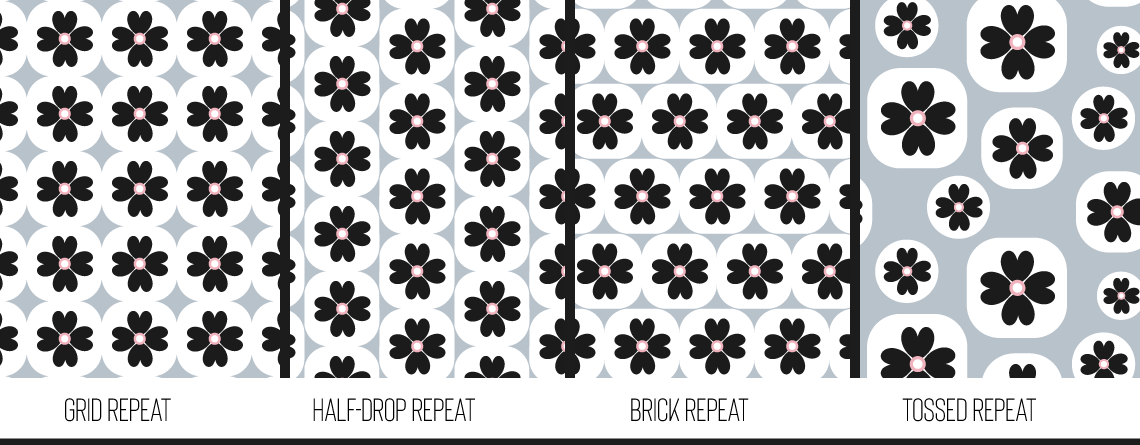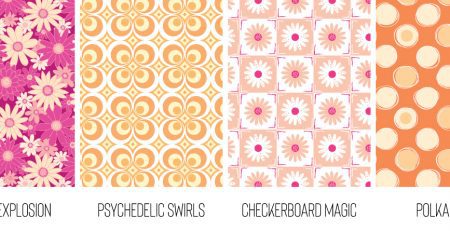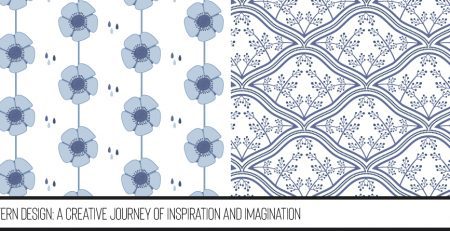Types of Surface Pattern Layouts: A Guide for Aspiring Pattern Designers
Are you an aspiring surface pattern designer looking to create captivating and visually appealing patterns? Understanding various surface pattern layouts is an essential step in crafting stunning designs that seamlessly repeat across fabrics, wallpapers, and various products. In this blog post, we’ll explore the different types of surface pattern layouts, with explanations tailored specifically for newcomers to the field of surface pattern design.
Half-Drop Repeat
In surface pattern design, a Half-Drop Repeat refers to a layout where the pattern elements stagger diagonally, dropping halfway down and to the side in each row or column. This creates an illusion of seamless movement, giving your design a dynamic and eye-catching look. This versatile layout technique adds a sense of movement and harmony to your designs, making it a popular choice among designers. The Half-Drop Repeat is widely used in fabrics, wallpapers, and various products to add an elegant and sophisticated touch. As an aspiring designer, you’ll find the half-drop repeat a versatile choice for creating sophisticated and seamless patterns.
Brick Repeat
In the exciting world of surface pattern design, the “Brick Repeat” is a classic and timeless layout technique that adds a sense of structure and order to your patterns. It is a repeating pattern layout that resembles the staggered pattern of bricks in a brick wall, hence its name. The Brick Repeat is widely used in various design industries, from textiles and wallpapers to ceramics and stationery, due to its visually appealing and versatile nature. The Brick Repeat is a layout where the pattern elements are arranged in a staggered, horizontal offset, much like the pattern of bricks in a wall. Each row is offset halfway from the adjacent row, creating a seamless and visually interesting design. The staggered arrangement gives the pattern a sense of movement and continuity, making it a popular choice for both modern and traditional designs.
Grid Repeat
Is a versatile and orderly layout technique that offers a structured and balanced look to your patterns. As the name suggests, this repeating pattern layout is based on a grid, providing a foundation for creating seamless and visually captivating designs. The Grid Repeat is widely used in various design industries, from textiles and home decor to digital graphics and stationery. The Grid Repeat is a layout where the pattern elements are arranged in a systematic grid formation. The motifs repeat uniformly along both horizontal and vertical axes, creating a seamless pattern that fills the canvas or surface without any gaps or overlaps. This layout offers a sense of order and precision, making it ideal for creating designs with a bold and organized appearance. The Grid Repeat is renowned for its sense of order and precision, making it suitable for a wide range of design styles, from modern and minimalist to intricate and traditional.
Tossed Repeat
Is a layout technique that adds a sense of spontaneity and playfulness to your patterns. Also known as a “scatter” or “random” repeat, the Tossed Repeat is designed to appear as though the motifs have been casually scattered across the canvas or surface. This repeating pattern layout brings a carefree and organic quality to your designs, making it a popular choice for various industries, from textiles and fashion to home decor and stationery. The Tossed Repeat is a layout where the pattern elements are arranged in a seemingly random manner, creating an effortless and dynamic design. Unlike regular repeats that follow a strict grid or alignment, the Tossed Repeat embraces asymmetry and irregularity, giving your patterns a fresh and spontaneous look. The motifs appear scattered, as if they were playfully tossed onto the surface.
This layout is perfect for designs with a whimsical and carefree vibe, adding a touch of spontaneity and fun to your patterns.
All-Over Repeat
An all-over repeat covers the entire surface without any distinct focal point, seamlessly repeating in all directions. Is a type of surface pattern layout where the design elements are evenly distributed across the entire surface, creating a continuous and seamless pattern. Unlike other layout types, there is no specific focal point or orientation, making it visually harmonious from any angle. All-over repeats are commonly used in fabrics, wallpapers, and various products due to their versatile and engaging nature. This layout is particularly popular for intricate and detailed patterns that are visually captivating from any angle.
As a newcomer to the world of surface pattern design, experimenting with these layout types will not only expand your creative horizons but also help you discover your unique design style. Play with various motifs, colors, and arrangements to see how each layout enhances your pattern’s visual impact.
Remember that the key to successful surface pattern design lies in achieving a balanced and captivating repeat. Pay attention to the edges of your pattern, ensuring they align seamlessly when tiled together. Additionally, consider the end use of your pattern, whether it’s for fabric, wallpaper, or other products, as this will influence your design decisions.
Embrace your artistic freedom and allow your creativity to soar as you embark on your surface pattern design journey. Practice, experiment, and don’t be afraid to break the rules to discover your own signature style.
In conclusion, understanding the various surface pattern layouts is an essential foundation for any aspiring surface pattern designer. Each layout type offers a unique visual effect, allowing you to create designs that resonate with your artistic vision and captivate your audience. So, dive in fearlessly, experiment passionately, and let your imagination lead the way in creating enchanting surface pattern designs!




